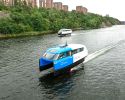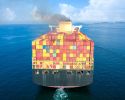New Report: Hydrogen and Methane Fuel Mix Hardly an Option for Shipping

Fuel blends of hydrogen mixed with methane have been successfully tested in smaller combustion engines. But how would it perform as a future alternative fuel in the maritime sector? Probably not very well, according to a new prel-study conducted within the Swedish Transport Administration’s industry program Sustainable Shipping, led by Lighthouse.
The pressure on the shipping industry to drastically reduce emissions is increasing. The EU has tightened its regulations, and the International Maritime Organization’s (IMO) goal of net-zero greenhouse gas emissions by 2050 must be achieved. This necessitates a shift from fossil fuels to some form of alternative propulsion. Among all the candidates for the marine fuel of the future, there is no obvious savior. One single solution won’t be enough—different types of shipping will require different types of propulsion. Therefore, all potential candidates must be tested. One of them is HCNG (Hydrogen Compressed Natural Gas), a blend of hydrogen and methane.
"It’s been tested technically at the lab level, but not in terms of how it would work in real-world applications. That’s why we examined it, both from a technical and economic perspective," says Ali Hedayati from IVL Swedish Environmental Research Institute, one of the researchers behind the report Mixing Hydrogen and Methane as Fuel for Ship Engines.
The study is divided into three main questions. The first is: How much hydrogen needs to be mixed with methane to achieve a meaningful reduction in carbon dioxide emissions? The second concerns where the mixing should occur—on land or onboard? The latter option would require both a hydrogen tank and an LNG tank onboard.
"The third question is about cost. Even if it works well technically, green hydrogen is much more expensive than methane—at least for now."
The results show that with 60% hydrogen in the fuel, carbon dioxide emissions are reduced by 30% compared to pure methane/LNG. To halve emissions, the fuel needs to consist of nearly 80% hydrogen.
"Since hydrogen has a low volumetric energy density, extremely large tanks are needed for storage. One alternative would be to liquefy the gas, but handling liquid hydrogen is both technically complex and very costly. It requires a fairly large tank with a pressure of at least 350 bar to manage pure hydrogen, which also presents a significant safety challenge. Today, we’re not sure whether such large tanks with the required technical properties can be used," says Ali Hedayati, and continues:
"The costs and risks of mixing hydrogen and methane onboard would also fall entirely on the shipowner."
Therefore, it may be more advantageous to blend and store hydrogen and methane in port rather than onboard ships. On land, the larger fuel volume poses fewer logistical challenges, and from a safety perspective, it’s easier to monitor and control risks such as hydrogen leaks, autoignition, and explosions.
"But that would require very large tanks—at least twice the size of LNG tanks—compared to if the fuel is blended on land. So it's hard to say which option is better: blending on land or onboard."
The preliminary study questions whether HCNG is a realistic alternative fuel for the maritime industry. Although blending hydrogen and methane does reduce CO₂ emissions, the technical challenges are too great and the costs too high—primarily due to the high price of hydrogen.
"If the fuel is composed of 50% hydrogen, which is needed to effectively reduce emissions, it will be twice as expensive as what shipping companies pay today. And if only hydrogen is used, the cost will be three times higher—just for the fuel alone. For this to be feasible in the future, the price of hydrogen must decrease significantly," says Ali Hedayati.
The pre-study Mixing Hydrogen and Methane as Fuel for Ship Engines was authored by Ali Hedayati, Anders Hjort, Tomas Lönnqvist, and Karl Jivén from IVL Swedish Environmental Research Institute, along with Simon Mischke, Alia Oualid Hessissen, Basil P. Thomas, and Zhiyuan Li from Chalmers University of Technology.
-
 Från motorbåt till militärfartyg – traineeprogrammet gav Isak nycklarna till sjöfartsbranschen
Från motorbåt till militärfartyg – traineeprogrammet gav Isak nycklarna till sjöfartsbranschen -
 DNV: Metanol är ett moget alternativt bränsle
DNV: Metanol är ett moget alternativt bränsle -
 Se Hållbar sjöfarts uppsamlingsheat
Se Hållbar sjöfarts uppsamlingsheat -
 NextWave – en podd som ska locka unga
NextWave – en podd som ska locka unga -
 Ny studie: Eldrivna pendelbåtar kan effektivisera Stockholms kollektivtrafik
Ny studie: Eldrivna pendelbåtar kan effektivisera Stockholms kollektivtrafik -
 Sjöfartens utsläpp ökar
Sjöfartens utsläpp ökar -
 Sociala relationer påverkar val av bränsle
Sociala relationer påverkar val av bränsle -
 Sjöfartens omställning kräver ”mjukare” påtryckningar
Sjöfartens omställning kräver ”mjukare” påtryckningar -
 Hon hade avtalad tid med Kapten ynkrygg
Hon hade avtalad tid med Kapten ynkrygg -
 Lighthouse omvärldsanalys 2025 – osäkerhet och tullar präglar sjöfarten
Lighthouse omvärldsanalys 2025 – osäkerhet och tullar präglar sjöfarten

